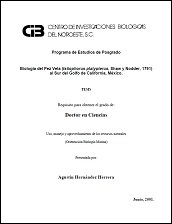Caracterización del nivel trófico de Megathura crenulata (Sowerby, 1825) mediante el uso de la señal isotópica del δ¹³C y δ¹⁵N
Resumen
"Megathura crenulata es un gasterópodo que habita a lo largo del litoral de la costa occidental de Baja California Sur. Tiene importancia económica y farmacológica debido a que su hemolinfa contiene una proteína importante para el tratamiento de algunos tipos de cáncer. En el presente trabajo se tuvo como objetivo analizar la señal isotópica del δ13C y δ15N de M. crenulata y de sus principales fuentes de alimento. En Bahía de Tortugas, BCS se realizaron colectas de organismos de M. crenulata, así como de dos especies de algas café Eisenia arborea y Macrocystis pyrifera, una especie de alga roja Gelidium robustum, tapetes de algas coralinas articuladas, una especie de pasto marino Phyllospadix torreyi y una especie de tunicados, Didemnum sp., en los meses de junio y noviembre del 2009 y 2010. Se encontró que el δ13C promedio de M. crenulata fue de -15 ‰ el cual se mantiene constante en los dos años mientras que el promedio general del δ15N fue de 14.8 ‰ y presenta diferencias entre un año y otro. E. arborea tuvo un δ13C de -19.7 ‰, M. pyrifera -15.2 ‰, las algas coralinas articuladas -11.5 ‰, Gelidium robustum -22.3 ‰ y Phyllospadix torreyi -18.1 ‰. En el caso del δ15N E. arborea tuvo una señal isotópica de 8.9 ‰, M. pyrifera 9.7 ‰, las algas coralinas 10.5 ‰, G. robustum 8.3 ‰ y P. torreyi 8 ‰. Los tunicados tuvieron un promedio general del δ13C de -9.3 ‰ y del δ15N de 8.1 ‰. G. robustum tuvo el mayor porcentaje de contribución a la señal isotópica de M. crenulata con 25%. A partir de los datos del δ15N de M. crenulata y G. robustum se obtuvo que el nivel trófico de M. crenulata es de 3.2 lo cual coincide con lo reportado para organismos omnívoros en trabajos isotópicos. En conclusión, la señal isotópica del gasterópodo refleja la de las macroalgas en mayor medida y muy poco del tunicado que había sido reportado como su principal fuente de alimento, sugiriendo que hay una mayor aportación alimenticia de las macroalgas a largo plazo." "Megathura crenulata is a native gastropod of the rocky shores from California, USA to Baja California Sur, Mexico. This species has economic and pharmacological importance because it contains an important element in the treatment of some cancers. The aim of this study is to analyze the isotopic signature of δ13C and δ15N of M. crenulata and their main food sources. In Bahía Tortugas, Baja California Sur, Mexico. Samplings were made in Bahia Tortugas, Baja California Sur, Mexico. Organisms of M. crenulata, two brown seaweeds: Eisenia arborea and Macrocystis pyrifera, one red seaweed: Gelidium robustum, articulated coralline algae, one seagrass: P. torreyi and one tunicate: Didemnum sp. were collected in July and november of 2009 and 2010. It was found that the δ13C of M. crenulata was -15 ‰ which remains constant for at least two years while the δ15N was 14.8 ‰ and differs from one year to another. E. arborea had an δ13C of -19.7 ‰, M. pyrifera -15.2 ‰, articulated coralline algae -11.5 ‰, G. robustum -22.3 ‰ and P. torreyi -18.1 ‰. The δ15N of E. arborea was 8.9 ‰, for M. pyrifera 9.7 ‰, coralline algae 10.5 ‰, G. robustum 8.3 ‰ and P. torreyi 8 ‰. The tunicates had an δ13C of -9.3 ‰ and δ15N of 8.1 ‰. G. robustum had the highest percentage of contribution to the isotopic signature of M. crenulata with 25%. With the δ15N it was obtained the trophic level of M. crenulata resulting 3.2 which agrees with an omnivorous organism in an isotopic approach. In conclusion, the gastropod isotope signal reflects the isotopic signature of macroalgae and very little of the tunicate that had been reported in stomach content analysis as their main food source, suggesting that there is a greater contribution of macroalgae in long term."
Colecciones
Ítems relacionados
Mostrando ítems relacionados por Título, autor o materia.
-
PROMOCIÓN DEL PERIFITON PARA EL CULTIVO DE CAMARÓN BLANCO: HACIA UNA ACUICULTURA ECOLÓGICA
DOMENICO VOLTOLINA LOBINA; JUAN MANUEL AUDELO NARANJO; MARIA DEL ROSARIO PACHECO MARGES -
Suelo y Erosión
YOLANDA LOURDES MAYA DELGADO


